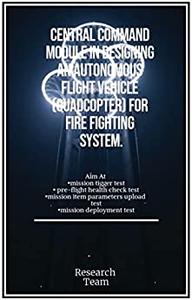CENTRAL COMMAND MODULE IN DESIGNING AN AUTONOMOUS FLIGHT VECHICLE
- Книги
- 8-03-2023, 00:07
- 157
- 0
- voska89

Free Download CENTRAL COMMAND MODULE IN DESIGNING AN AUTONOMOUS FLIGHT VECHICLE (QUADCOPTER) FOR FIRE FIGHTING SYSTEM by Research Team
English | 2022 | ISBN: N/A | ASIN: B0BDXL1BWC | 93 pages | EPUB | 1.68 Mb
This work presents the 'Central command module in Designing an autonomous flight vechicle (quadcopter) for First Responder Firefighting system'. Robotic applications are becoming more common in highly hazardous environments in order to reduce any potential risk to humans especially in the area of firefighting. One example is the creation of Drone also known as Unmanned Aerial vehicles (UAVs), which have provided safer alternatives to many high risk situations. The system is designed to operate in an open environment. It is capable of responding to triggered fire signal sent from given a sensor location; it takes off autonomously from its home location to the location of the sensor in a straight path; on arrival, it activates its fire extinguishing system in an attempt to combat the flame/fire. The overall system engineering process for the First Responder firefighting was partitioned into three sub systems, namely: Sensor module, Central command and the Quadcopter (drone). Appropriate computer programs were developed to ensure the flow of data between the subsystems. The adopted design model for the development of the First Responder Firefighting Drone was the V model process model also known as the verification and validation model, which involves several sub processes such as Requirements modelling, Architectural design, Sub systems design Construction and Code generation, Unit or subsystem testing, Integration testing, System testing and Acceptance testing. The result of test on the quadcopter showed that it could take off due to flight signal sent to it by the remote controller and autonomous flight script from central command module. The sensor module performance test carried out showed that once it was set up in operation mode, it could search and connect automatically to the central command unit thereby sending the location information and status to the central command unit at every 1 second interval. The central command module testing showed that this subsystem could respond to the sensor data sent to it by the sensor module subsystem; from there it could take autonomous decision by sending a flight signal to the quadcopter. This was also confirmed through the robotic system simulator. From the result obtained so far it can be inferred that this project attempts to proffer solution to the prevailing challenges of firefighting in most industrial layout
Links are Interchangeable - No Password - Single Extraction
